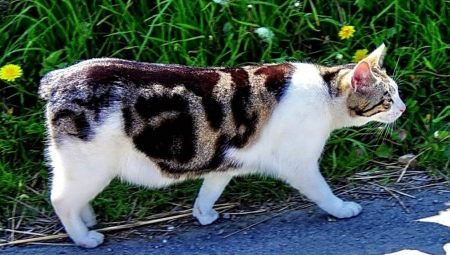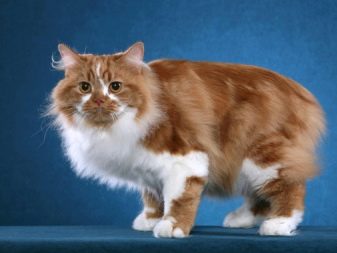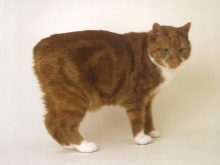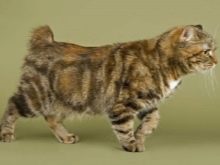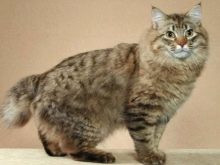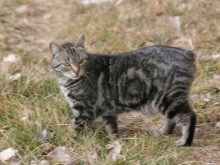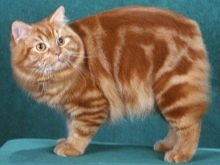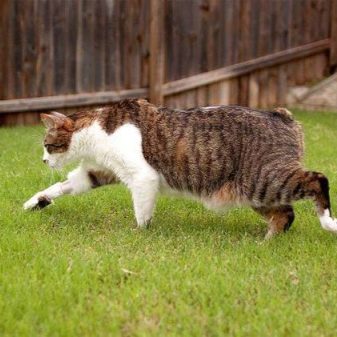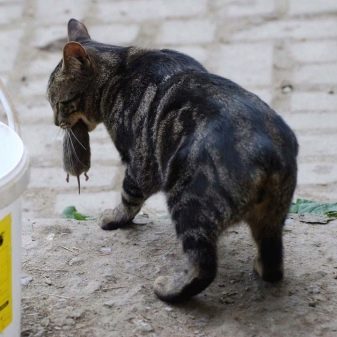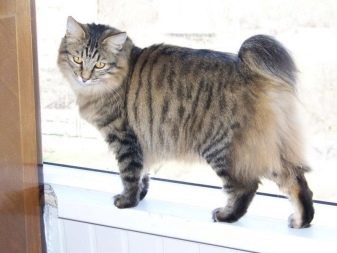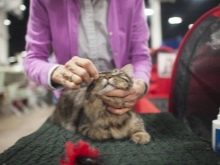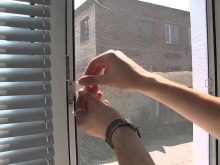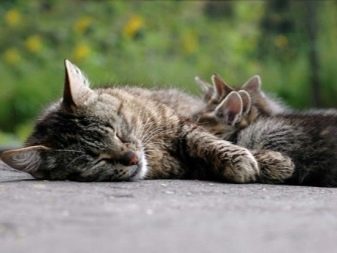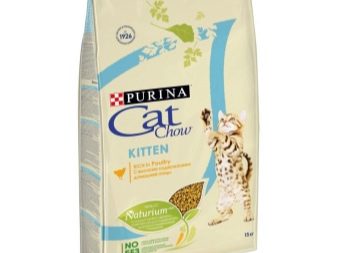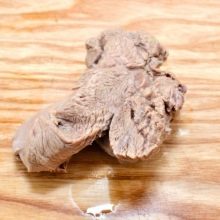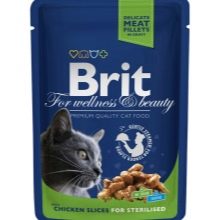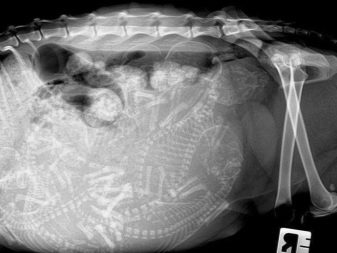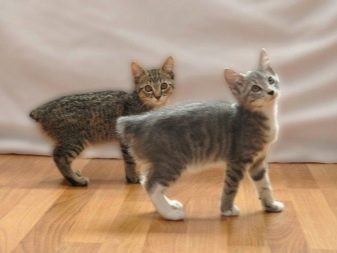There is a legend that the cat Manx was late for Noah's Ark, and the closing door cut off her tail. Cats from the Isle of Man are tailless by nature, it is a stable gene mutation. This type of cat is very popular in the USA, UK, Scandinavian countries. Tailless cats are a symbol of good luck and happiness on the Isle of Man: they are idolized, the inhabitants of the island are proud of them, and also depicted on English coins and postage stamps.
History of origin
The history of the origin of Manx cats is ambiguous, there are several versions:
- Most likely, representatives of this breed come from Asia, because they are also found in Russia and China, but it is on the Isle of Man that the tailless gene was passed on to all individuals inhabiting it today;
- according to another version, these cats are descendants of the Japanese Bobtail breed with a very short tail;
- according to the third version, they got to the island from a sunken Spanish ship.
The inhabitants of the island are delighted with these cats and it does not matter how this breed was introduced: tailless cats were reflected not only on coins, but also on jewelry, in painting and various works of art.
Description
At the very beginning of the 20th century, the Manx cat lovers club was founded and the standard of pure breeding of these animals was adopted, where the main feature is not the absence of a tail, but the special structure of the spine and, as a result, the “jumping gait”.
The most thoroughbred is considered a type of ramp - a cat without a single caudal vertebra. Less valuable variety - rayser (these individuals have cartilage and a bundle of hair instead of a tail). Stumpy are owners of a short hooked tail (they are no longer allowed to exhibitions).
Long - the usual tail of medium length, it turns out such a cat when crossing two ramps. Access to exhibitions is closed to them, but they are very much in demand as partners for mating with the ramp - from such a union, pure-blooded Maen cats with very good health are obtained.
Cats and cats of the Mank breed are very different in size: female representatives are unusually tiny, like 4-month-old kittens. The average weight of females is 4 kg, males - more than 5 kg.
Distinctive features of pedigree are spelled out in a special standard of the Manx breed:
- these cats have a peculiar "rabbit gait";
- they have a rounded head with large round and slightly slanting eyes;
- bulging cheekbones;
- short, thick neck;
- high set ears with a slope forward;
- correct teeth bite;
- strong double chin;
- muscular strong body;
- powerful hips and rounded ass;
- hind legs slightly longer than the front;
- they have a strong skeleton, broad chest and sunken sides, short hair with undercoat.
The breed Manx is considered to be shorthair, and long-haired tailless cats are separated into a separate breed, the Cymric (such a cat is considered unique, since it is almost impossible to find a pair for breeding that meets strict breed standards).
Cymric cats are an endangered species.
Manxes live long enough - about 14 years, there are some long-livers among them who have lived up to 20 years.
Character traits
By their character, Manx cats resemble dogs: loyal, intelligent, good-natured, get along well with children and dogs, playful, deeply attached to all family members.These cats love to watch the flowing water and fish, they catch rodents well, and also love to climb trees, but they do not know how to go down.
Tailless cats are also unique in that they are easy to train like dogs - they can learn to bring things and run after the ball. Menksy do not need walking on the street, most of them are couch potatoes, but the best of this breed breed in a private house, where they will feel themselves masters of the backyard territory. But they can adapt to any living conditions, up to a small apartment.
Coat color options
The coat color options of the Manx cats are so varied that even the official breed standard does not have a precise description. The coat color of tailless cats can be almost anything except:
- Siamese and other "hybrid" drawings;
- lilac and chocolate colors.
Much more important than the color is the presence of a thick undercoat in combination with silky hairs of medium length. This wool is found in rabbits, it is plush and silky at the same time.
According to breed standard The coat color of the Manx cat must be in harmony with the color of the eyes.
Conditions of detention
Maine cats need daily combing of the hair with a comb of medium hardness, the use of a furminator is permissible no more than two times a week and only during seasonal molting. It is also necessary to wash the eyes 1 time per week or as far as it becomes dirty (if the eyes are constantly dirty, this may indicate the presence of an infection, in which case the cat should be shown to the vet).
Auricles should be wiped once a week with a cotton pad dipped in 3% hydrogen peroxide. Cleaning teeth should be carried out in the presence of plaque.
This procedure can be entrusted to a specialist or performed independently with the help of a soft brush-file holder and a special cat's toothpaste.
To prevent the occurrence of plaque on the teeth of the pet, it can be given special dry food.
Tailless cats need to trim their claws. The first time it is better to carry out the procedure with a specialist in order to clearly understand how to cut the claws properly and with what tools without harming the pet's health.
Manxes like to look at the water, but they do not like to wash in the shower, so if the pet is a homebody, it is better to wash it only in case of emergency: on the eve of the exhibition, mating or giving birth (you can use the basin and jug with water to avoid stress in the animal). At the bottom of the bath it is necessary to lay a thick terry towel, turn on the shower at room temperature, lather your hands with a special shampoo, wash the animal and rinse gently without touching your ears. After bathing, you must wrap the cat in a towel. After 5 minutes, this towel must be changed to dry. In the room where the cat dries, there should be no drafts, it is desirable to warm the air to 25-27 degrees, ideally, until the animal is completely dry, it should be kept in a towel.
Tray tailless cats should always be clean, so it makes sense to use lumpy granules, absorbing moisture and odor, as a filler. Additionally, you will need a kogtetochka with a house and toys. Manxes are very curious, so you need to install additional protection on the windows (mosquito nets only create the appearance of security, in fact, they are fragile and easily broken).
Feeding
In the first 2 months of life, the kittens need only mother's milk, then you can begin to enter the lure with scrambled boiled meat once a day (the first feeding is 1/5 teaspoon), after a week you can gradually introduce low-fat cottage cheese, slightly diluted with water. It is recommended to keep such a power scheme for up to 4 months.
When the kittens are 4 months old, you can give dry food, starting with a few pieces per day, gradually increasing their number to the norm by the weight of the animal, according to the instructions for the feed.
Also from 4 months it is time to start introducing vitamins and minerals into the pet's diet.
The number of feedings per day depends on the age of the kittens (at 4 months you need 4 feedings, 5 already only 2 times a day, as well as adult individuals). After purchasing a kitten for about 2 weeks, you need to adhere to the food set by the breeder, then it is better to consult a veterinarian and draw up an individual menu.
Usually the daily diet of Maine cats includes:
- 1/3 premium dry food (preferably large, solid pieces that need to be crushed);
- 1/3 natural products (boiled beef and poultry, cottage cheese with a low percentage of fat, scalded with boiling water sea fish without bones, 1 quail boiled egg per week, 1 tablespoon of oatmeal on the water per day - it is recommended to mix it with wet food);
- 1/3 wet super premium and premium feed.
After each meal, you must throw away the leftovers and wash the dishes, in a clean bowl should always be clean drinking water. Cat grass is recommended to keep on the floor so that the cat does not drop it from the window sill. To feed "from the table" tailless cats is strictly prohibited, they have a special curved spine, in which it is strictly forbidden to gain excess weight.
It is necessary to promptly vaccinate and carry out the prevention of parasites according to the schedule agreed with the veterinarian. Do not spare the strength to search for a good veterinarian, such unusual cats should be monitored constantly, visit a doctor at least 2 times a year to avoid problems with the spine, overweight, etc. If an animal has any disease (intervertebral hernia, vision problems) , digestive tract dysfunction, limb dystrophy), the individual is considered culled and is not allowed to mating. Perhaps in this case need sterilization.
Breeding
Not all kittens in the litter are born tailless, and if you cross the two tailless, you will have offspring with ordinary tails (the tail gene gives such an effect as a minus to a minus gives a plus). Therefore, to keep a nursery for breeding individuals of this breed is extremely unprofitable. If the kitten dock its tail, it will undermine its health, even death is possible.
You can not cross the representatives of the Manx breed with individuals of other breeds.
The most healthy, strong offspring with a minimum set of genetic diseases is born from the union of the Manx long-tail individuals and ramps. Puberty at Menks comes at 3 years old, it is not recommended to arrange mating up to this age.
A cat can give birth to no more than 4 kittens, if the ultrasound shows 6 individuals, then a cesarean section will be required, otherwise the cat will die in childbirth.
Participation in exhibitions is allowed mainly a kind of ramp, sometimes rayser. When buying, please note that in Russia there are no official kennels of tailless cats and you can buy them only from private owners. According to the cost of rampy, riser and stumpi are different: the shorter the tail, the more expensive the kitten. Also, the price increases with the presence of champion titles from parents.
When buying a kitten, it must be at least 4 months old, a purebred must necessarily have a jumping gait. A healthy kitten has good hair, clean eyes, ears and nose, and is also very playful and mobile.
When buying a kitten, a package of documents is attached to it: a contract of sale and purchase, a passport (it contains the name, date of birth, pedigree) and a certificate of vaccinations.
The minimum price for a kitten is 500 dollars, and if his parents are champions of exhibitions, then it can reach up to 2 thousand dollars. Purebred kittens are never sold with discounts, because it is very difficult to find a pair for mating, and many kittens are rejected by the 4th month.
It is impractical, risky and very expensive to breed tailless cats for sale. Do not forget that these cats are often "golden" customers for veterinarians: in addition to constant monitoring, there may be numerous hereditary diseases. It is more expedient to purchase any short-haired purebred cat, it has an order of magnitude less genetic diseases and restrictions on exhibitions. However, as pets, the Menxes are beautiful in their own way.
On the features of the breed Manx cats, see the following video.
